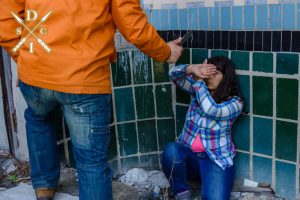Measuring Your Personal Awareness

Dignitary Protection and Security Group wants you to be aware of your surroundings and personal safety. To combat ever-increasing personal assaults, batteries, and street crimes, we are presenting this article with some basic information that can help protect you and your loved ones. Please share it with everyone in your household.
What is personal awareness?
Personal awareness is the state of knowing what is going on around your vicinity. Staying focused and undistracted are important points to remember.
What does that mean?
It means that when you are aware of your surroundings and you cannot be “startled.” Criminals who are stalking you, watching your movements, or looking for victims choose those who are unaware.
How is this important?
Typically, a criminal will rely on the lack of awareness of their victims. If a criminal can gain control of their victims, then they can exert their efforts in whatever they are trying to do… rob, rape or murder you.
How do professionals rate awareness?
Awareness is measured by most firearms professionals by the color code developed by the late Colonel Jeff Cooper of Gunsite Firearms Training Center in Arizona. Colonel Cooper’s awareness code is laid out in the following:
White: Head in the clouds, asleep. Most people are in this state. Easily startled.
They do not see what is going on around them. Often, they are the targeted victims. Anyone buried in texting on their phone, talking to others, engaging a stranger in conversation, window shopping, aimlessly entering or leaving a venue. All of this is especially dangerous in the dark.
Yellow: Heightened awareness. Aware of who and what is around them. Not paranoid. Aware of escape possible escape routes.
People who walk with more conviction, head directly for their planned entry or exit. They get in their car with their keys at the ready. They have their valuables concealed and tucked away. They avoid high crime areas or potentially dangerous situations, like the approach of groups at night who are all wearing dark clothing to conceal themselves. Before they become immersed in conversation or distracted, even inside a store, they locate the nearest exits, doorways, and potential help in an emergency.
Orange: Possible threat(s) sighted. Oriented on the threat. Decision on best routes of escape.
At this level, the aware individual is ready to react. If they are armed, they should have been trained to deal with the conflict properly. If unarmed or caught in an unfamiliar situation, they will proceed immediately to the nearest exit, signal others that there is a crime about to be committed, recognize, and focus on the attacker and attempt to extricate themselves.
Red: Defensive action taken-shots fired. Utilizing escape route to evade attackers.
Once an attack occurs it is time to react quickly. Armed individuals’ training should kick in and they defend their lives. They leave the area if possible, as soon as possible. If unarmed they flee. They do not expect help from others as we have often seen lately, people are more interested in videotaping attacks than getting involved.
DPSG instructs our Concealed Carry Handgun (CCH) students that once they carry a concealed firearm, they exit their homes in condition yellow. You must be aware, checking your complete surroundings. Start looking for and veering away from “hiding spots” and other areas where you cannot observe for threats. Use unusual walking patterns if needed to give yourself distance from any obstacle or location where someone could be waiting. It only takes a moment to be blindsided.
Check intersections before driving through them (even on a green light). Watch cars to make sure they are stopping at the stop signs as you approach. If you believe you are being followed drive to the nearest police station or other safe location. At night, find a well-lit, busy location and seek help inside as possible.
Actions like these are really just active observation. During code yellow you do not walk while looking at your cell phone nor continue a phone call. You are casually aware of and paying attention to your surroundings.
In condition orange you have seem something that is out of place; someone is paying too much attention to you. You notice someone is following you or trying to intercept you. They may be moving against the flow or look somehow out of place. You have observed them, now you pay attention directly to them (making sure you do not develop tunnel vision and miss their partners).
At this point you decide what your trigger points are: You place your hand on the butt of your weapon (maybe clearing it depending on surroundings), you decide if you will retreat, or decide if you will engage.
Code red: You have decided to engage. You do not let them decide. It may be 25 feet away. According to the Tueller theory you must have more than 23 feet of distance to defend against an edged weapon like a sword or knife attack. Once you decide to engage or flee-you do it! Once it is decision time you do not hesitate! Do not attempt to render aid to the criminal you shot as they may still have a weapon and can harm you.
If you are aware of your surroundings and use a similar code of awareness, then you have a pathway to success. You must be ready to employ these ideas. Practice scenarios around your home or in a safe space. Play acting in your head what you would do if someone did jump out at you from a concealed location will help you react properly if it happens.
You now must work on your state of mind.
Can you shoot someone?
Be honest with yourself! If you decide you cannot do it, then do not carry a firearm! It will be taken from you and used against you! Never, ever pull a weapon out without the specific intent to use it. It is deadly force. Once you have committed to firing the weapon, do so. There is a good possibility that even if you miss your target they will withdraw. No one wants to get shot. Your attacker will know you are armed, serious, and willing to take their life. You have changed the dynamic and defended yourself. Criminals like easy targets. Don’t become one.
You must never brandish a weapon. Always understand and follow the specific requirements in your state’s criminal code.
Good luck!
DPSG specializes in personal protection at many levels. Please review our site to learn more about how you can keep yourself, your friends and family, and co-workers safe. A trained and aware person is the best defense against unwanted criminal actions. Call DPSG to inquire about individualized training and concealed carry classes.


